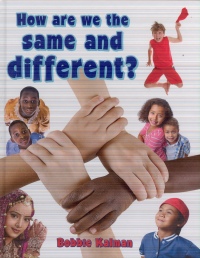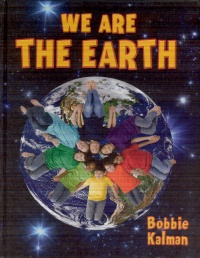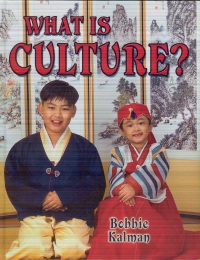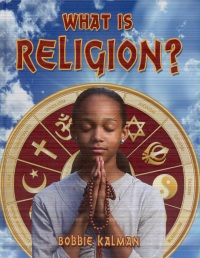| ________________
CM . . .
. Volume XVI Number 11. . . .November 13, 2009 
 |
How Are We the Same and Different? (Our Multicultural World).
Bobby Kalman.
St. Catharines, ON: Crabtree, 2009.
32 pp., pbk. & hc., $9.95 (pbk.), $20.76 (hc.).
ISBN 978-0-7787-4648-5 (pbk.), ISBN 978-0-7787-4633-1 (hc.).
Subject Headings:
Toleration-Juvenile literature.
Differences (Psychology)-Juvenile literature.
Grades 2-3 / Ages 7-8.
Review by Gail Hamilton.
** /4
|
| |
|
 |
We Are the Earth. (Our Multicultural World).
Bobby Kalman.
St. Catharines, ON: Crabtree, 2009.
32 pp., pbk. & hc., $9.95 (pbk.), $20.76 (hc.).
ISBN 978-0-7787-4649-2 (pbk.), ISBN 978-0-7787-4634-8 (hc.).
Subject Heading:
Earth-Juvenile literature.
Grades 2-3 / Ages 7-8.
Review by Gail Hamilton.
** /4
|
| |
|
 |
What Is Culture? Our Multicultural World).
Bobby Kalman.
St. Catharines, ON: Crabtree, 2009.
32 pp., pbk. & hc., $9.95 (pbk.), $20.76 (hc.).
ISBN 978-0-7787-4650-8 (pbk.), ISBN 978-0-7787-4635-5 (hc.).
Subject Heading:
Culture-Juvenile literature.
Grades 2-3 / Ages 7-8.
Review by Gail Hamilton.
** /4
|
| |
|
 |
What is Religion? (Our Multicultural World).
Bobby Kalman.
St. Catharines, ON: Crabtree, 2009.
32 pp., pbk. & hc., $9.95 (pbk.), $20.76 (hc.).
ISBN 978-0-7787-4651-5 (pbk.), ISBN 978-0-7787-4636-2 (hc.).
Subject Heading:
Religions-Juvenile literature.
Grades 2-3 / Ages 7-8.
Review by Gail Hamilton.
** /4
|
| |
|

excerpt:
We live in a multicultural world. Multicultural means "made up of many cultures." People are different, but we are also the same. We are the same because we all need air, water, and food. We are the same because we all share the same home. Earth is our home. We are connected to one another because we live on Earth. (From What is Culture?)
The new "Our Multicultural World" series is designed to introduce young readers to the basics of the world's major religions and cultures as well as to encourage them to celebrate diversity and work together in harmony. Each title consists of 14 chapters, a table of contents, a glossary, an index and a list of books for further reading. It is no surprise that the list is comprised of other Crabtree series, but many of the recommended books are written at a much higher reading level. The text, printed in a large, simple font, is rather stilted due to its short, choppy sentences and its repetition. Throughout the series, several concepts and illustrations are repeated, and, though the drawings and colour photos are vibrant and appealing, some of the captions state the obvious—for example, "This girl is bending backwards."
How Are We the Same and Different? explores the commonalities and differences of people all over the world: they have the same basic needs (food, sunshine, shelter, water and air); they are all mammals, primates and living things; and they all call the planet Earth their home. But each person is unique in terms of talents, beliefs and culture. This title also discusses some of the ways in which children can make this world a better place, the importance of having an "attitude of gratitude," and four ways to find happiness (through breathing, as in meditation, sending positive thoughts, spending quiet time alone for contemplation, and living in the now). Though these last four ideas are certainly worthy, they might be too abstract for young children to comprehend.
We Are the Earth describes the connection between humans and the natural world. Some topics include the importance of the sun's energy, the various states of water, plants and photosynthesis, the relationship between carbon dioxide and oxygen as it pertains to respiration, and the trend toward "going green" and becoming eco-friendly. Unfortunately, this book does not seem to have a clear focus. It is doubtful that young readers will be able to apply some of the concepts to the photos (e.g. there is a photo of a girl jumping into the air, and the caption reads, "This girl is using the sun's energy to jump high in the air"), nor will they readily understand the following quote: "When you touch a flower, you touch the sun." Once again, the author devotes a large section to gratitude (as mentioned in the previous title), and there is a double-page spread showing pictures of animals and youngsters doing the "gratitude dance," hardly a good use of space. Finally, there is a photograph of Earth, but the lower portion is hidden and looks as if it is submerged under water. For children who are just starting to delve into nonfiction, this could be confusing.
Culture is described as the way people express themselves through their clothing, language, stories, music, art, architecture, sports, religious beliefs and food. In What is Culture? readers will learn about the importance of history in terms of legends, art, buildings, costumes and traditions. This title promotes multiculturalism by showing how people in different parts of the world dress, play, eat, dance, worship, and celebrate holidays. Some of the information about religion is repeated in another title.
What is Religion? introduces readers to some of the world's major religions: Christianity, Judaism, Islam, Hinduism, Buddhism, Sikhism and a few of the religions of East Asia as well as Native American beliefs. Topics include the religions' origins, symbols, basic tenets, places and forms of worship, sacred texts, founders and teachers. The information is very basic, and in some cases, a bit too sparse. For example, there is mention of the Jewish Bar Mitzvah, but the purpose of the ceremony is not explained. On a positive note, the book does try to promote respect for others' beliefs.
Due to the inconsistency, between titles, in the explanation of concepts, this series would benefit from slight revision in order to make the concepts clearer for the intended audience.
Recommended with reservations.
Gail Hamilton is a teacher-librarian in Winnipeg, MB.

To comment
on this title or this review, send mail to cm@umanitoba.ca.
Copyright © the Manitoba Library Association. Reproduction for personal
use is permitted only if this copyright notice is maintained. Any
other reproduction is prohibited without permission.
NEXT REVIEW |
TABLE OF CONTENTS FOR THIS ISSUE
- November 13, 2009.
AUTHORS |
TITLES |
MEDIA REVIEWS |
PROFILES |
BACK ISSUES |
SEARCH |
CMARCHIVE |
HOME |



